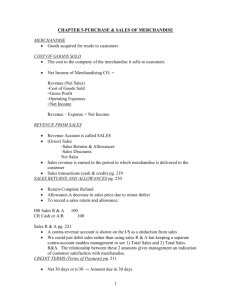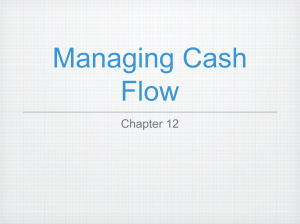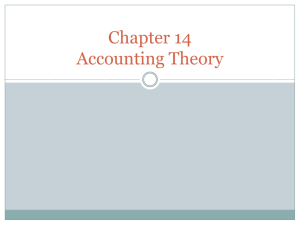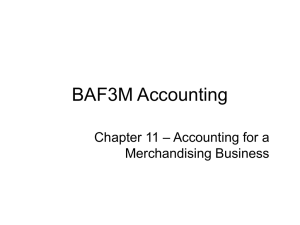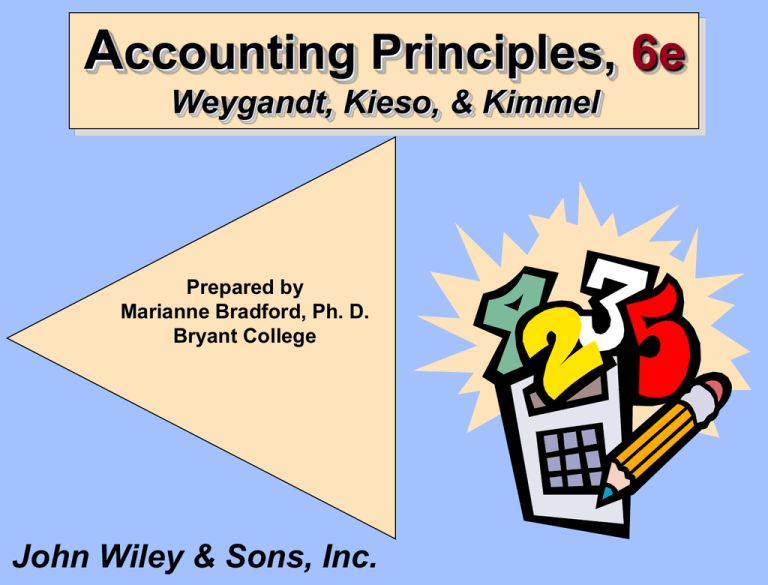
Accounting Principles, 6e
Weygandt, Kieso, & Kimmel
Prepared by
Marianne Bradford, Ph. D.
Bryant College
John Wiley & Sons, Inc.
CHAPTER 5
ACCOUNTING FOR MERCHANDISING OPERATIONS
After studying this chapter, you should be able to:
1 Identify the differences between a service
enterprise and a merchandising company.
2 Explain the entries for purchases under a
perpetual inventory system.
3 Explain the entries for sales revenues under a
perpetual inventory system.
4Explain the steps in the accounting cycle for a
merchandising company.
CHAPTER 5
ACCOUNTING FOR MERCHANDISING OPERATIONS
After studying this chapter, you should be able to:
5 Distinguish between a multiple-step and a
single-step income statement.
6 Explain the computation and importance of
gross profit.
PREVIEW OF CHAPTER 5
Accounting for
Merchandising Operations
Merchandising
Operations
Operating cycles
Inventory Systems
Recording Purchases of
Merchandise
Purchase returns and
allowances
Freight costs
Purchase discounts
PREVIEW OF CHAPTER 5
Accounting for
Merchandising Operations
Completing the
Accounting Cycle
Recording Sales of
Merchandise
Sales returns and
allowances
Sales Discounts
Adjusting entries
Closing entries
Summary of entries
PREVIEW OF CHAPTER 5
Accounting for
Merchandising Operations
Forms of Financial
Statements
Multiple-step income
statement
Single-step income
statement
Classified balance sheet
STUDY OBJECTIVE 1
Identify the differences between a service
enterprise and a merchandising company.
MERCHANDISING COMPANY
A merchandising company is an
enterprise that buys and sells goods to
earn a profit.
1) Wholesalers sell to retailers
2) Retailers sell to consumers
A merchandiser’s primary source of
revenue is sales.
MEASURING NET INCOME
Expenses for a merchandising company are divided
into two categories:
1) cost of goods sold and
2) operating expenses
Cost of goods sold is the total cost of merchandise
sold during the period.
Operating expenses are expenses incurred in the
process of earning sales revenue. Examples are sales
salaries and insurance expense.
Gross profit is equal to Sales Revenue less Cost of
Goods Sold.
ILLUSTRATION 5-1
INCOME MEASUREMENT PROCESS FOR A
MERCHANDISING COMPANY
Sales
Revenue
Less
Equals
Cost of
Goods Sold
Gross
Profit
Less
Equals
Operating
Expenses
Net
Income
(Loss)
ILLUSTRATION 5-2
OPERATING CYCLES FOR A SERVICE
COMPANY AND A MERCHANDISING COMPANY
Service Company
Receive
Cash
Cash
Perform
Services
Accounts
Receivable
Merchandising Company
Receive
Cash
Buy
Inventory
Cash
Sell Inventory
Accounts
Receivable
Merchandise
Inventory
INVENTORY SYSTEMS
Merchandising entities may use either of the
following inventory systems:
1) Perpetual
Detailed records of the cost of each item are
maintained, and the cost of each item sold is
determined from records when the sale occurs.
2) Periodic
Cost of goods sold is determined only at the end of
an accounting period.
COST OF GOODS SOLD
The cost of goods sold may be determined
each time a sale occurs or at the end of an
accounting period.
To make the determination when the sale
occurs, a company uses a perpetual inventory
system.
When the cost of goods sold is determined
only at the end of an accounting period, a
company is said to be using a periodic
inventory system.
COST OF GOODS SOLD
To determine the cost of goods sold
under a periodic inventory system, it is
necessary to:
1) Determine the cost of goods on hand at
the beginning of the accounting period.
2) Add to it the cost of goods purchased.
3) Subtract the cost of goods on hand at
the end of the accounting period
STUDY OBJECTIVE 2
Explain the entries for purchases
under a perpetual inventory system.
PURCHASES OF
MERCHANDISE
When merchandise is purchased for resale to
customers, the account, Merchandise Inventory, is
debited for the cost of goods.
Like sales, purchases may be made for cash or on
account (credit).
The purchase is normally recorded
by the purchaser when the goods
are
received from the seller.
Each credit purchase should be
supported by a purchase invoice.
PURCHASES OF
MERCHANDISE
GENERAL JOURNAL
Date
May 4
Account Titles and Explanation
Merchandise Inventory
Accounts Payable
(To record goods purchased on
account, terms 2/10, n/30, from
Highpoint Electronic)
For purchases on account,
Merchandise Inventory is debited
and Accounts Payable is credited.
Dr.
Cr.
3,800
3,800
PURCHASE RETURNS
AND ALLOWANCES
A purchaser may be dissatisfied with merchandise
received because the goods
1) are damaged or defective,
2) of inferior quality, or
3) not in accord with the purchaser’s
specifications.
The purchaser initiates the request for a
reduction of the balance due through the issuance of a
debit memorandum.
The debit memorandum is a document issued by a
buyer to inform a seller that the seller’s account has
been debited because of unsatisfactory merchandise.
PURCHASE RETURNS
AND ALLOWANCES
GENERAL JOURNAL
Date
May 8
Account Titles and Explanation
Accounts Payable
Merchandise Inventory
(To record return of inoperable
goods received from Highpoint
Electronic, DM No. 126)
Dr.
Cr.
300
For purchases returns and allowances,
Accounts Payable is debited and
Merchandise Inventory is credited.
300
FREE ON BOARD
The sales agreement should indicate whether the
seller or the buyer is to pay the cost of transporting
the goods to the buyer’s place of business.
FOB Shipping Point
1) Goods placed free on board the carrier
by seller
2) Buyer pays freight costs
FOB Destination
1) Goods placed free on board at
buyer’s business
2) Seller pays freight costs
ACCOUNTING FOR
FREIGHT COSTS
Merchandise Inventory is debited if
buyer pays freight.
Freight-out (or Delivery Expense) is
debited if seller pays freight.
ACCOUNTING FOR
FREIGHT COSTS
GENERAL JOURNAL
Date
May 6
Account Titles and Explanation
Merchandise Inventory
Cash
(To record payment of freight,
terms FOB shipping point)
Dr.
Cr.
150
150
When the purchaser directly incurs the freight costs, the account
Merchandise Inventory is debited and Cash is credited.
ACCOUNTING FOR
FREIGHT COSTS
GENERAL JOURNAL
Date
May 4
Account Titles and Explanation
Freight-out (Delivery Expense)
Cash
(To record payment of freight on
goods sold FOB destination)
Dr.
Cr.
150
Freight costs incurred by the seller on outgoing
merchandise are debited to Freight-out (or
Delivery Expense) and Cash is credited.
150
PURCHASE DISCOUNTS
Credit terms may permit the buyer to claim
a cash discount for the prompt payment of
a balance due.
The buyer calls this discount a
purchase discount.
Like a sales discount, a
purchase discount is based on
the invoice cost less returns
and allowances, if any.
PURCHASE DISCOUNTS
GENERAL JOURNAL
Date
May 14
Account Titles and Explanation
Accounts Payable
Cash
Merchandise Inventory
(To record payment within
discount period)
Dr.
3,500
Cr.
3,430
70
If payment is made within the discount period, Accounts
Payable is debited, Cash is credited, and Merchandise
inventory is credited for the discount taken.
PURCHASE DISCOUNTS
GENERAL JOURNAL
Date
June 3
Account Titles and Explanation
Accounts Payable
Cash
(To record payment with no
discount taken)
Debit
Credit
3,500
If payment is made after the discount
period, Accounts Payable is debited and
Cash is credited for the full amount.
3,500
SAVINGS OBTAINED BY TAKING
PURCHASE DISCOUNT
A buyer should usually take all available discounts.
If Chelsea Video takes the discount, it pays $70 less in cash.
If it forgoes the discount and invests the $3,500 for 20 days
at 10% interest, it will earn only $19.06 in interest.
The savings obtained by taking the discount is calculated as
follows:
Discount of 2% on $3,500
Interest received on $3,430 (for 20days at 10%)
Savings by taking the discount
$ 70.00
( 19.06)
$ 50.94
STUDY OBJECTIVE 3
Explain the entries for sales revenues
under a perpetual inventory system.
SALES TRANSACTIONS
Revenues are reported when earned in accordance
with the revenue recognition principle, and in a
merchandising company, revenues are earned when
the goods are transferred from seller to buyer.
All sales should be supported
by a document such as a
cash register tape or sales
invoice.
RECORDING CASH SALES
GENERAL JOURNAL
Date
May 4
4
Account Titles and Explanation
Cash
Sales
(To record daily cash sales)
Cost of Goods Sold
Merchandise Inventory
(To record cost of merchandise
sold for cash)
Dr.
Cr.
2,200
2,200
1,400
1,400
For cash sales, Cash is debited and Sales is credited.
For the cost of goods sold for cash, Cost of Goods
Sold is debited and Merchandise Inventory is credited.
RECORDING CREDIT SALES
GENERAL JOURNAL
Date
May 4
4
Account Titles and Explanation
Accounts Receivable
Sales
(To record credit sales to Chelsea
Video per invoice #731)
Cost of Goods Sold
Merchandise Inventory
(To record cost of merchandise
sold on invoice #731 to Chelsea
Video)
Dr.
Cr.
3,800
3,800
2,400
2,400
For credit sales, Accounts Receivable is debited and Sales is credited.
For the cost of goods sold on account, Cost of Goods Sold is debited
and Merchandise Inventory is credited.
SALES RETURNS AND
ALLOWANCES
Sales Returns result when customers are
dissatisfied with merchandise and are allowed
to return the goods to the seller for credit or a
refund.
Sales Allowances result when
customers are dissatisfied, and the
seller allows a deduction from
the selling price.
SALES RETURNS AND
ALLOWANCES
To grant the return or allowance, the
seller prepares a credit memorandum to
inform the customer that a credit has
been made to the customer’s account
receivable.
Sales Returns and Allowances is a contra
revenue account to the Sales account.
The normal balance of Sales Returns
and Allowances is a debit.
RECORDING SALES RETURNS
AND ALLOWANCES
GENERAL JOURNAL
Date
May 8
8
Account Titles and Explanation
Sales Returns and Allowances
Accounts Receivable
(To record return of inoperable
goods delivered to Chelsea Video,
per credit memorandum)
Merchandise Inventory
Cost of Goods Sold
(To record cost of goods returned
per credit memorandum)
Dr.
Cr.
300
300
140
140
The seller’s entry to record a credit memorandum involves a debit to
the Sales Returns and Allowances account and a credit to Accounts
Receivable. The entry to record the cost of the returned goods involves
a debit to Merchandise Inventory and a credit to Cost Goods Sold.
SALES DISCOUNTS
A sales discount is the offer of a cash discount
to a customer for the prompt payment of a
balance due.
Example: If a credit sale has the terms 3/10,
n/30, a 3% discount is allowed if payment is
made within 10 days. After 10 days there is no
discount, and the balance is due in 30 days.
Sales Discounts is a contra revenue account
with a normal debit balance.
CREDIT TERMS
Credit terms specify the amount and time
period for the cash discount.
They also indicate the length of time in which
the purchaser is expected to pay the full
invoice price.
T E R M S
E X P L A N A T I O N
2/10, n/30
A 2% discount may be taken if payment is made
within 10 days of the invoice date.
1/10 EOM
A 1% discount is available if payment is made
by the 10th of the next month.
RECORDING
SALES DISCOUNTS
GENERAL JOURNAL
Date
May 14
Account Titles and Explanation
Cash
Sales Discounts
Accounts Receivable
(To record collection within 2/10,
n/30 discount period from Chelsea
Video)
Dr.
3,430
70
When cash discounts are taken by
customers, the seller debits Sales Discounts.
Cr.
3,500
STUDY OBJECTIVE 4
Explain the steps in the accounting
cycle for a merchandising company.
CLOSING ENTRIES
Adjusting entries are journalized from the adjustment
columns of the work sheet.
All accounts that affect the determination of net income are
closed to Income Summary.
Data for the preparation of closing entries may be obtained
from the income statement columns of the work sheet.
GENERAL JOURNAL
Date
2002
Dec. 31
Account Titles and Explanation
(1)
Debit
Sales
Income Summary
(To close income statement
accounts with credit balances)
480,000
Credit
480,000
CLOSING ENTRIES
Cost of Goods Sold is a new account that must be closed to
Income Summary.
GENERAL JOURNAL
Date
2002
Dec. 31
Account Titles and Explanation
(2)
Income Summary
Sales Returns and Allowances
Sales Discounts
Cost of goods sold
Store Salaries Expense
Rent Expense
Freight-out
Advertising Expense
Utilities Expense
Depreciation Expense
Insurance Expense
(To close income statement
accounts
with debit balances)
Debit
Credit
450,000
12,000
8,000
316,000
45,000
19,000
7,000
16,000
17,000
8,000
2,000
CLOSING ENTRIES
GENERAL JOURNAL
Date
2002
Dec. 31
Account Titles and Explanation
(3)
Income Summary
R. A. Lamb, Capital
(To close net income to capital)
Debit
Credit
30,000
30,000
(4)
31
R. A. Lamb, Capital
R. A. Lamb, Drawing
(To close drawings to capital)
15,000
15,000
After the closing entries are posted, all temporary accounts
have zero balances.
It addition, R. A. Lamb, Capital has a credit balance of
$98,000 ($83,000 + $30,000 - $15,000).
STUDY OBJECTIVE 5
Distinguish between a multiple-step
and a single-step income statement.
MULTIPLE-STEP
INCOME STATEMENT
Includes sales revenue, cost of goods
sold and gross profit sections
Additional nonoperating sections may
be added for:
1) Revenues and expenses resulting
from secondary or auxiliary
operations
2) Gains and losses unrelated to
operations
MULTIPLE-STEP
INCOME STATEMENT
Nonoperating sections are reported after
income from operations and are classified as:
1) Other revenues and gains
2) Other expenses and losses
3) Operating expenses may be subdivided
into:
a) Selling Expenses
b) Administrative Expenses
ILLUSTRATION 5-11
SINGLE-STEP INCOME STATEMENT
HIGHPOINT ELECTRONIC
Income Statement
For the Year Ended December 31, 2002
Revenues
All data are classified under
Net sales
two categories:
Interest revenue
1 Revenues
Gain on sale of equipment
2 Expenses
Total revenues
Expenses
Only one step is required in
Cost of goods sold
$ 316,000
determining net income or
Selling expenses
76,000
net loss.
Administrative expenses
38,000
Interest expense
1,800
Casualty loss from vandalism
200
Total expenses
Net income
$ 460,000
3,000
600
463,600
432,000
$ 31,600
STUDY OBJECTIVE 6
Explain the computation and
importance of gross profit.
ILLUSTRATION 5-7
COMPUTATION OF GROSS PROFIT
Gross profit is determined as
follows:
Net sales
$ 460,000
Cost of goods sold
316,000
Gross profit
$ 144,000
ILLUSTRATION 5-9
OPERATING EXPENSES IN
COMPUTING NET INCOME
Net income is determined as
follows:
Gross profit
$ 144,000
Operating expenses
114,000
Net income
$ 30,000
STUDY OBJECTIVE 7
Prepare a worksheet for a
merchandiser
ILLUSTRATION 5-A1
WORK SHEET FOR A
MERCHANDISING COMPANY
HIGHPOINT ELECTRONIC
Work Sheet
For the Year Ended December 31, 2002
Account Titles
Cash
Accounts Receivable
Merchandise Inventory
Prepaid Insurance
Store Equipment
Accumulated Depreciation
Accounts Payable
R.A. Lamb, Capital
R.A. Lamb, Drawing
Sales
Sales Returns and Allowances
Sales Discounts
Cost of Goods Sold
Freight-out
Advertising Expense
Rent Expense
Store Salaries Expense
Utilities Expense
Totals
Insurance Expense
Depreciation Expense
Salaries Payable
Totals
Trial Balance
Dr.
Cr.
9,500
16,100
40,500
3,800
80,000
16,000
20,400
83,000
15,000
480,000
12,000
8,000
315,500
7,000
16,000
19,000
40,000
17,000
599,400 599,400
Adjustments
Dr.
Cr.
A 500
B 2,000
C 8,000
A 500
D 5,000
B 2,000
C 8,000
15,500
Adjusted
Trial Balance
Dr.
Cr.
9,500
16,100
40,000
1,800
80,000
24,000
20,400
83,000
15,000
480,000
12,000
8,000
316,000
7,000
16,000
19,000
45,000
17,000
2,000
8,000
D 5,000
15,500
612,400
5,000
612,400
USING A WORK SHEET
Trial Balance Columns
1 Data from the trial balance are obtained from
the ledger balances of Sellers Electronic at
December 31.
2 The amount shown for Merchandise
Inventory, $40,500, is the year-end inventory
amount which results from the application of
a perpetual inventory system.
USING A WORK SHEET
Adjustments Columns
1 A merchandising company usually has the
same types of adjustments as a service
company.
2 Work sheet adjustments b, c, and d are for
insurance, depreciation, and salaries.
Adjusted Trial Balance - The adjusted trial
balance shows the balance of all accounts after
adjustment at the end of the accounting period.
ILLUSTRATION 5-11
WORK SHEET FOR A
MERCHANDISING COMPANY
HIGHPOINT ELECTRONIC
Work Sheet
For the Year Ended December 31, 2002
Account Titles
Cash
Accounts Receivable
Merchandise Inventory
Prepaid Insurance
Store Equipment
Accumulated Depreciation
Accounts Payable
R.A. Lamb, Capital
R.A. Lamb, Drawing
Sales
Sales Returns and Allowances
Sales Discounts
Cost of Goods Sold
Freight-out
Advertising Expense
Rent Expense
Store Salaries Expense
Utilities Expense
Totals
Insurance Expense
Depreciation Expense
Salaries Payable
Totals
Net Income
Totals
Adjusted
Trial Balance
Dr.
Cr.
9,500
16,100
40,000
1,800
80,000
24,000
20,400
83,000
15,000
480,000
12,000
8,000
316,000
7,000
16,000
19,000
45,000
17,000
2,000
8,000
612,400
Income
Statement
Dr.
Cr.
Balance Sheet
Dr.
Cr.
9,500
16,100
40,000
1,800
80,000
24,000
20,400
83,000
15,000
480,000
12,000
8,000
316,000
7,000
16,000
19,000
45,000
17,000
2,000
8,000
5,000
612,400
450,000
30,000
480,000
480,000
480,000
162,400
5,000
132,400
162,400
30,000
162,400
USING A WORK SHEET
Income Statement Columns
1 The accounts and balances that affect the
income statement are transferred from the
adjusted trial balance columns to the income
statement columns for Sellers Electronic at
December 31.
2 All of the amounts in the income statement
credit column should be totaled and compared
to the total of the amounts in the income
statement debit column.
USING A WORK SHEET
Balance Sheet Columns
1 The major difference between the balance
sheets of a service company and a
merchandising company is inventory.
2 For Sellers Electronic, the ending
Merchandise Inventory amount of $40,000 is
shown in the balance sheet debit column.
3 The information to prepare the owner’s equity
statement is also found in these columns.
COPYRIGHT
Copyright © 2002 John Wiley & Sons, Inc. All rights reserved. Reproduction or
translation of this work beyond that permitted in Section 117 of the 1976 United
States Copyright Act without the express written consent of the copyright owner is
unlawful. Request for further information should be addressed to the Permissions
Department, John Wiley & Sons, Inc. The purchaser may make back-up copies for
his/her own use only and not for distribution or resale. The Publisher assumes no
responsibility for errors, omissions, or damages, caused by the use of these
programs or from the use of the information contained herein.
CHAPTER 5
ACCOUNTING FOR MERCHANDISING OPERATIONS

